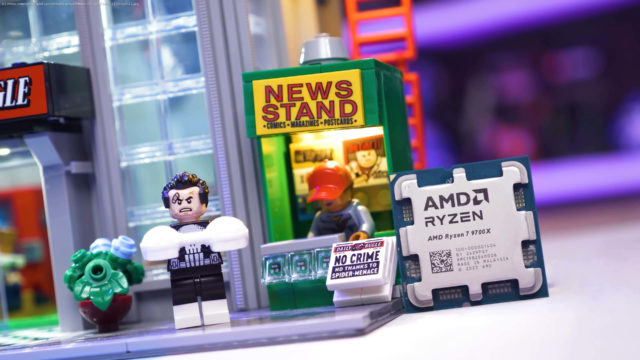AMD keeps botching their product launches, and Zen 5 is just another example in a string of releases over the last two years that range from disappointing.
AMD keeps botching their product launches, and Zen 5 is just another example in a string of releases over the last two years that range from disappointing to downright embarrassing. There’s a concerning trend of AMD shooting themselves in the foot, misleading potential customers through questionable marketing, and making simple blunders that, if avoided, would have led to a much better experience for buyers.
In today’s column, I’m going to run through AMD’s recent poor launches and give my thoughts on what’s happened, what’s gone wrong, and what AMD can do to improve. The goal, I guess, is to expose the problem and publicly push for change because better launches with more accurate marketing mean that you, the consumer, end up with better products on day one. And better products that aren’t disappointing or underwhelming to begin with are better for the entire PC ecosystem.
I want to start with what a good launch looks like. The most recent example I think of from AMD is the Ryzen 7 7800X3D. This CPU was launched in January 2023, and if we go back and look at the announcement, they talk about this part being the ultimate gaming processor. They showed performance figures that were between 21% and 30% faster than the Ryzen 7 5800X3D and ended up releasing the part for $450. An exciting product announcement given the 5800X3D was one of the most popular CPUs on the market at the time.
Fast forward to our day-one review later that April, and we found that the 7800X3D was indeed one of the fastest gaming CPUs on the market, narrowly outperforming the Core i9-13900K. We also confirmed that it was 24% faster on average compared to the 5800X3D, validating AMD’s marketing claims. Ultimately in our review, we said the value of this part can’t be beaten among high-end parts. Accurate marketing set expectations appropriately, they were met in third-party benchmarks, the price is great in the current market, everyone is happy, and the CPU starts off as a huge success.
The Zen 4 product launch wasn’t quite as smooth due to high motherboard and memory prices at the time, and some of the parts weren’t amazing value – but at the very least, AMD set expectations well at the announcement.
They claimed Ryzen 7000 offered up to 29% more single-core performance versus Ryzen 5000. We found that was accurate. They advertised substantial multi-core gains, including up to a 57% lead for the 7950X over the Core i9-12900K – in some workloads like Blender, that was accurate.
Some of the gaming performance numbers were a little optimistic compared to what we found, but not that far off, especially given we tested with faster memory. Companies are always going to show their products in the best possible light, but as long as the claims made are not misleading to customers, the exact percentages being a bit different is acceptable.
Where AMD began to falter with launches was with the Radeon 7000 series. Almost every product in that RDNA3 lineup had some sort of blunder at launch, and expectations were set far too high to match the actual performance of the products.
It began with the Radeon RX 7900 XTX. Back at launch, AMD claimed this part was up to 1.7x faster than the RX 6950 XT at 4K gaming, or on average 55% faster with a minimum 1.5x performance gain. When it was revealed this part would cost just $1,000, it sounded amazing, especially compared to Nvidia’s RTX 4090 that was set at $1,600. These performance slides suggested that, at least for rasterization, performance would be roughly around that of the 4090.
But when we reviewed the GPU, we found that it was just 35% faster than the 6950 XT at 4K across a 16-game sample, falling well short of the RTX 4090 and being more of an RTX 4080 competitor.
At the time, AMD suggested to us this discrepancy was because our 6950 XT was „too fast“, which is quite a funny thing to say about your own product. Ultimately, Steve described this GPU as underwhelming and overhyped.
If expectations weren’t set at a huge 1.5 to 1.7 times performance advantage generation over generation, the initial reception to this product could have been better. It wasn’t amazingly priced, but it was competitive against the RTX 4080. Much could have been made about its price-to-performance ratio at the high end and being the fastest card below $1,000, but instead, AMD decided to exaggerate the performance claims, and this led to prospective buyers feeling disappointed when the final data came in. Avoidable to some degree if expectations were accurately set at launch.
To make matters worse, the other RDNA 3 launch GPU was a catastrophe. The Radeon 7900 XT never made sense at $900, even looking at AMD’s own launch presentation. While AMD never compared the two parts in benchmarks, they clearly showed the GPU design was cut down from 96 to 84 compute units, those CUs were clocked lower, and it had a smaller memory bus. With the XT model cut down by at least 15% relative to the XTX, the XT model was never going to be able to justify its mere 10% lower price. And AMD should have known that, based on their internal testing and just the simple hardware configuration the engineers had gone with.
When we found the 7900 XT was 17% slower than the 7900 XTX on average at 4K, Steve proclaimed the card was dead on arrival – and it was. No one would pay 10% less to get 17% less performance at the high end. The price was horrendous, and a huge launch fail for a card that AMD told us they expected to sell very well. They had made loads of these units. But somehow they didn’t realize that a sizable hardware reduction for only a small cost saving isn’t at all appealing to customers.
These two launches set the tone for AMD’s RDNA3 generation. At a time when customers were desperate for good value graphics cards, having just waded through years of crap thanks to crypto miners inflating GPU prices, both of AMD’s initial Radeon 7000 series GPUs were a flop. AMD overhyped the flagship card to the point it was disappointing despite offering a reasonable performance uplift, and the 7900 XT was priced out of contention.
Reviews and feedback at launch are crucial for the success of a product. If feedback is largely negative, it’s hard to overcome that through price corrections and fixes later down the line. Lots of people only watch the initial reviews, make up their mind, and if the product is deemed bad at launch, they ignore it thereafter.
By the time price cuts roll in, it’s too late; the hype for that product is gone, and word has already gone out that the product or even the entire product series sucks. But if the launch is a success, hype builds, word-of-mouth excitement spreads, people want the product in their hands, and that’s huge for both the company and the customer. Not only are you getting a good product that’s worth buying on day one, but the company also benefits from organic feedback.
All the 7900 XT required at launch was a price that actually made sense given the hardware configuration. It’s not a bad card, the hardware itself isn’t terrible, and we even said we could have recommended it at $800. At launch, that would have been a potentially exciting price and generated a bit of interest, but AMD couldn’t help themselves and shot their own foot.
What’s been even more bizarre about AMD’s product releases is they went on to repeat this mistake with the Radeon 7700 XT. AMD announced the 7800 XT at $500 and the 7700 XT at $450, which at the time we said was too expensive.
Given the hardware configuration with a 10% cut down of the GPU core relative to the 7800 XT, along with much less memory bandwidth and lower VRAM capacity, it was very likely to be more than 10% slower at just a 10% reduction in price. Lo and behold, we found it was 16% slower for 1440p gaming, and we called it a repeat of the 7900 XT and told readers not to buy it at its launch price.
Again, AMD should have known internally that the 7700 XT’s $450 asking price made absolutely no sense in their own lineup. Just one look at the specifications would have told you that, and then benchmarks would have confirmed it. Not having a coherent price structure for your own products in the same lineup is embarrassing and just confuses your customers.






